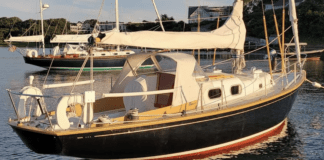
Unless you own a late-model Catalina, or are an assiduously thorough shopper, you may not recognize the name Garhauer as a manufacturer of sailboat hardware. Nonetheless, the company has been around since—as president Bill Felgenhauer explains it—”someone asked me to make some stuff for them.” That was 34 years ago. Today, the privately owned company boasts $4.5 million in sales, which include not only blocks, boom vangs, stanchions, bow rollers, and such, but also fuel tanks and machine gun mounts for the US Navy. And why Catalina Yachts? Because Garhauer is an OEM supplier for that California-based boat builder.
Among the 35 people who work for Felgenhauer at the company’s Upland, CA, plant are his two sons, daughter, and daughter-in-law. The latest products from “the family” are Garhauer’s updated Unibody blocks, which were actually introduced three years ago. (We wrote about the precursor “hollow blocks” in our June 15 issue, 1995.) These new blocks attracted our attention in part due to their novel look, but also owing to the fact that Garhauer won Best Buy honors in our Feb. 15, 2000 test of snatch blocks. At the time, we pronounced those blocks “simple, strong, and cheap.” It’s nice to know from the outset that the Unibody blocks are covered by the same 10-year, unconditional guarantee that applies to all Garhauer products.
Unibody blocks are fabricated in two ways. The bodies of certain models are cut from a solid piece of metal plate and then folded over—hence the name—while others are milled from solid aluminum. Common to all models is an open core with no center pin to anchor the sheave. Instead, the cheeks support a circular insert pressed into the sheave. This, according to Felgenhauer, evenly distributes the total load across a larger surface area than with center pin arrangements. There is, in essence, a larger diameter axle for the sheave. These new blocks also lack fasteners that are found in many load-strap type configurations; there are no rivets or load-bearing screws in the block. The idea here is that those invariably form the weak links that invite corrosion in a salt water environment.
The 50-13 UB was one of seven blocks we examined. The stainless steel post is insulated from contact with the milled anodized aluminum cheeks by a Delrin bushing on both the top and the bottom of the pin. The block housing has a small Allen wrench key allowing the block to function in either a swivel or in a fixed position depending on its application. This block is milled from a solid piece of 6061 T-aluminum, and it’s further lightened by 12 holes that are drilled in the outside of the sheave.

This kind of attention to weight is likely as much for aesthetics as performance since most Garhauer clients are from the cruising end of the sailing spectrum. The center ring is grayish anodized aluminum around which twin sets of some 40 Torlon bearings rotate so that the sheave spins freely. Upon close inspection, it may look like a bearing or two are missing, but that’s intentional. “Sooner or later salt deposits get in there,” explained Felgenhauer, “and Torlon expands a little bit—as much as 10 percent. Pretty much all the block manufacturers leave two or three balls out for expansion and to give the salt a place to go. The balls shouldn’t rub against each other, so it’s a good thing if there’s a little space between these balls.”
This particular block has a breaking limit of 5,000 lbs. and a safe working load of 3,500 lbs. It weighs 11 oz. and is priced at $66. Garhauer also offers a titanium version, which weighs only 10 oz. and has a safe working load of 2,500 lbs. for an additional $22. That block finally pulled apart in a laboratory test at 6,600 lbs. “The shackle broke,” said Felgenhauer, “and the block was a little rough because the bearings had deformed, but it still spun.”
The 40-13 USG is a new 9-ounce block with a 2400-lb. safe working load and a breaking strength of 4,800 lbs. Priced at $36.30, this block is being produced by Garhauer on a larger scale than the milled version. It has a stainless shackle with a screw pin secured by a clevis ring—assurance against accidental release should the shackle bounce around during tacking. The titanium version of this block—titanium shackle and post—jumps $20 in price to save just an ounce of weight and add 200 pounds more breaking strength.
Rather than being milled from a block like the 50-13UB, the cheek for this block is laser cut from a single piece of aluminum, which is then folded in half. This is a less expensive process and thus comes with a corresponding decrease in price. The post runs through a D-shaped Delrin bridge that fits into the radius of the bend. This block also has a set screw in it, although this runs through the Delrin bridge rather than the cheek, which allows for a swivel or fixed alignment. The edges of the aluminum sheave are solid. And this block also features Torlon bearings.
We went to our local West Marine store to find some comparably sized and shaped blocks in order to compare prices. Lewmar’s 1611 60-mm is a high-load block with aluminum alloy cheeks and sheave, an open center, a SWL of 1,764 lbs., and a breaking strength of 3,527 lbs., priced at $86.99. Harken’s Black Magic 1950 also has an open center with a SWL of 2,500 lbs. and a breaking load of 5,000 lbs. It’s constructed of anodized aluminum cheeks, a UV stabilized Delrin sheave, Delrin ball bearings, and Torlon rollers, and lists for $94.99 with a 5-year warranty. Compared to these two blocks, the Garhauer 50-13UB—at $66 with a 10-year guarantee—is a relative bargain.

We were impressed with the Unibody blocks’ finish quality and pricing. The milled blocks are more robustly rated than those with the folded aluminum cheeks. However, the location of the holes in the sheave of the milled 50-13UB are quite close to the outer edge of the sheave and that might concern some boat owners. But Felgenhauer pointed out that those edges aren’t under load, adding that in the three years these models have been on the market, there haven’t been any problems reported.
The option of using the stainless steel Allen set screw to make the block swiveling or fixed is handy, though we think using Loc-Tite would be in order for both the heavy use these blocks will endure and to keep the aluminum block insulated from corrosion; ditto for the set screw in the titanium version 40-13USG. The entire line is available in polished stainless steel, and either grey or black anodized aluminum.
So why don’t you see more Garhauer products around, and why aren’t their products standard equipment for other production boat builders? For one, explained Felgenhauer, the Catalina account keeps his company very busy, so busy that they haven’t yet approached other builders. He allowed that the company does make some chain plates for Island Packet Yachts and has begun selling products to owners of J/Boats on a more regular basis.
“We try to keep prices on a reasonable level,” he said. “For one thing, we sell direct aftermarket. There’s nobody in between. While we have dealers on both coasts, you can call us up and we’ll send it to you. We’ve been called the working sailor’s friend. I guess the guy that has a Hinckley doesn’t need us that badly, but the guy that spent his last cent buying a cruising boat, for him it’s a little different story.”
Contact – Garhauer Marine Hardware, 909/985-9993, www.garhauer.com.







































